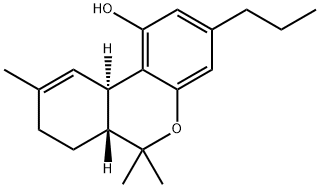COMPUTED DESCRIPTORS
| Molecular Weight | 286.4 g/mol |
|---|---|
| XLogP3 | 5.9 |
| Hydrogen Bond Donor Count | 1 |
| Hydrogen Bond Acceptor Count | 2 |
| Rotatable Bond Count | 2 |
| Exact Mass | 286.193280068 g/mol |
| Monoisotopic Mass | 286.193280068 g/mol |
| Topological Polar Surface Area | 29.5 Ų |
| Heavy Atom Count | 21 |
| Formal Charge | 0 |
| Complexity | 412 |
| Isotope Atom Count | 0 |
| Defined Atom Stereocenter Count | 2 |
| Undefined Atom Stereocenter Count | 0 |
| Defined Bond Stereocenter Count | 0 |
| Undefined Bond Stereocenter Count | 0 |
| Covalently-Bonded Unit Count | 1 |
| Compound Is Canonicalized | Yes |
PRODUCT INTRODUCTION
description
Tetrahydrocannabivarin (THCV) is a propyl analogue of tetrahydrocannabinol (Δ9-THC), one of the primary pharmacological components of [Medical Cannabis]. Δ9-THC is currently available in several synthetic forms, including [Dronabinol], while purified or isolated THCV is not approved for any medical uses and is not available as any marketed products. As a major phytocannabinoid, however, THCV is accessible within [Medical Cannabis] along with other identified cannabinoids including [Cannabidiol] (CBD), [cannabinol] (CBN), [cannabigerol] (CBG), [cannabichromene] (CBC), [cannabivarin] (CBV), and [Cannabidivarin] (CBDV). THCV is one of four cannabinoids with identified potential as anticonvulsant agents, which also includes Δ9-tetrahydrocannabinolic acid, [Cannabidiol] (CBD), and [Cannabidivarin] (CBDV). Although THCV possesses an almost identical structure to Δ9-THC (varying only by the length of its lipophilic alkyl chain), it has different molecular targets and pharmacological profile. Compared to THC which demonstrates its effects through weak partial agonist activity of both endocannabinoid receptors Cannabinoid-1 (CB1R) and Cannabinoid-2 (CB2R), THCV acts as a CB1 antagonist and a partial agonist of CB2. Further evidence has also shown that THCV acts as an agonist of GPR55 and l-α-lysophosphatidylinositol (LPI). Beyond the endocannabinoid system, THCV has also been reported to activate 5HT1A receptors to produce an antipsychotic effect that has therapeutic potential for ameliorating some of the negative, cognitive and positive symptoms of schizophrenia. Furthermore, THCV interacts with different transient receptor potential (TRP) channels including TRPV2, which may contribute to the analgesic, anti-inflammatory and anti-cancer effects of cannabinoids and Cannabis extracts. It has also shown antiepileptiform and anticonvulsant properties, that suggest possible therapeutic application in the treatment of pathophysiologic hyperexcitability states such as untreatable epilepsy. Cannabinoid receptors are utilized endogenously by the body through the endocannabinoid system, which includes a group of lipid proteins, enzymes, and receptors that are involved in many physiological processes. Through its modulation of neurotransmitter release, the endocannabinoid system regulates cognition, pain sensation, appetite, memory, sleep, immune function, and mood among many others. These effects are largely mediated through two members of the G-protein coupled receptor family, cannabinoid receptors 1 and 2 (CB1 and CB2). CB1 receptors are found in both the central and peripheral nervous systems, with the majority of receptors localized to the hippocampus and amygdala of the brain. Physiological effects of using cannabis make sense in the context of its receptor activity as the hippocampus and amygdala are primarily involved with regulation of memory, fear, and emotion. In contrast, CB2 receptors are mainly found peripherally in immune cells, lymphoid tissue, and peripheral nerve terminals. Reliably studying the effects of Cannabis (and of THCV) is complicated by the numerous other compounds that Cannabis contains such as terpenes, flavonoids, phenols, amino acids, and fatty acids among many others that have the potential to modulate the plant's pharmacological effect.
